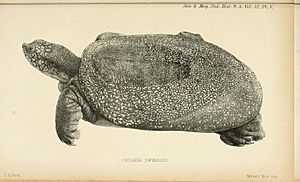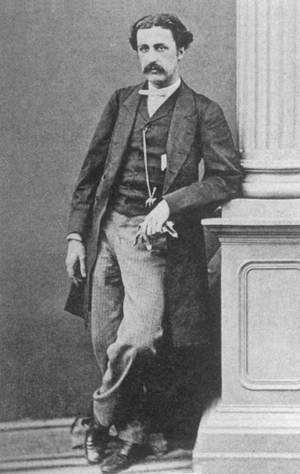Robert Swinhoe facts for kids
Robert Swinhoe (born September 1, 1836 – died October 28, 1877) was an English diplomat and a naturalist. A naturalist is someone who studies nature, especially plants and animals. He worked as a British Consul in Taiwan. A consul is like a country's official representative in another country.
Swinhoe studied many birds in Southeast Asia. Several birds, like the Swinhoe's pheasant, are named after him because of his important discoveries.
Contents
Robert Swinhoe's Life and Work
Early Life and Career
Robert Swinhoe was born in Kolkata, India, in 1836. At that time, Kolkata was part of the British Empire. His father was a lawyer. Robert later moved to England and studied at the University of London. In 1854, he joined the British consular service in China.
In 1855, he was sent to a port city called Amoy (now Xiamen). It was about 300 miles northeast of Hong Kong. While there, he became very good at speaking Chinese. He learned both official Mandarin and the local Amoy dialect. He also started to study the birds of eastern China in great detail.
In 1857, he married Christina Stronach in Amoy. She was the daughter of a Scottish missionary.
Adventures in Taiwan and China
In 1856, Swinhoe made an exciting trip to the camphor-producing areas of northwestern Taiwan. He traveled on a special boat called a lorcha, which had a European body and Chinese sails. It's not known if this trip was for work or just for fun.
In 1858, Swinhoe helped search for British and American sailors who were lost at sea around Taiwan. He was also a translator for the British during two conflicts in North China in 1858 and 1860. He wrote a book about his experiences during the Second Opium War.
Becoming a Consul in Taiwan
In 1860, Swinhoe was chosen to be the first European consul on the island of Taiwan. He finally arrived there in July 1861. He and his assistant first went to the capital city, Taiwan-fu (now Tainan).
However, the harbor in Tainan was too shallow for big ships. So, Swinhoe moved the British consulate to the northern port of Tamsui. This port was where most of the foreign trade happened. He wrote many articles about his early days as a consul and about the amazing wildlife of Taiwan.
Later Postings and Discoveries
After Taiwan, Swinhoe worked as a consul in other Chinese cities like Amoy, Ningbo, and Yantai. He also traveled a lot for the British government. He explored Hainan island and journeyed up the Yangtze River to Chongqing. He helped figure out if steamships could travel on the river.
Even with all these duties, he remained the consul for Taiwan until he retired in 1873. During his free time in China, he collected many natural history specimens. Since these areas had not been explored by Westerners before, many of his findings were new to science.
He was mainly interested in birds. Many of his new discoveries were birds, but he also found new fish, mammals, and insects. He brought his collection back to England in 1862. Many of the birds he found were first described in a famous book called Birds of Asia by John Gould.
Robert Swinhoe's Contributions to Natural History

From a young age, Robert Swinhoe loved birds. He collected British birds, their nests, and eggs. He started publishing his findings in 1858. This was the same year that Charles Darwin and Alfred Russel Wallace shared their ideas about natural selection. Swinhoe liked Darwin's ideas. In 1872, he even named a bird subspecies after Darwin.
Swinhoe regularly wrote for important science journals like The Ibis and the Proceedings of the Zoological Society of London.
Collecting Animals
During his travels, he studied birds and mammals. He also learned about the local cultures. He collected both live animals and specimens. He often sent them to the London Zoo. The first Pere David's deer in Europe came from him.
His main interest was birds. He often wrote to other scientists, like Edward Blyth, about his bird discoveries.
Illness and Legacy
Around 1871, Swinhoe started to suffer from partial paralysis. This meant he had trouble moving parts of his body. He moved to Yantai, which he called the "Scarborough of China." His illness forced him to leave China in October 1875.
Even from his home in Chelsea, England, he continued to publish his notes. His last publication was about a new type of bird called Liocichla steerii.
After his death, famous scientists praised his work. Philip Sclater called him "one of the most hardworking and successful exploring naturalists ever." A. R. Wallace said that thanks to Swinhoe, we know more about the animals of China's coast and islands than almost anywhere else in the world.
His collection of 3,700 specimens was bought by Henry Seebohm. This collection was later given to the Liverpool Museum.
Animals Named After Swinhoe
Many animals are named in Robert Swinhoe's honor. Four species of mammals and 15 species of birds carry his name. This includes Swinhoe's storm-petrel, which he first described himself in 1867.
Also, four types of reptiles are named after him:
- Gekko swinhonis
- Diploderma swinhonis
- Rhabdophis swinhonis
- The Yangtze giant softshell turtle (Rafetus swinhoei). Swinhoe sent a specimen of this turtle to a scientist named John Edward Gray in 1873.
Robert's brother, Colonel Charles Swinhoe, was also a naturalist. He helped start the Bombay Natural History Society in India and was an expert on butterflies and moths.
Images for kids
-
This drawing shows the Yangtze giant softshell turtle. Robert Swinhoe sent a specimen of this turtle to the British Museum.



